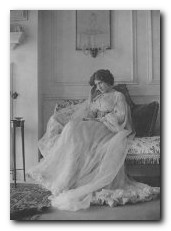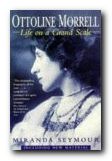society hostess and patron of the arts
 Ottoline Morrell (1873-1938) features in the history of the Bloomsbury Group largely as a hostess and patron of the arts. From 1908 onwards, she entertained a wide circle of political and literary celebrities at her Thursday evening gatherings in Bedford Square, and at her country retreat at Garsington Manor in Oxfordshire. She was born Ottoline Violet Anne Cavendish Bentinck in 1873, acquiring the title of ‘Lady’ when her half-brother inherited the duchy of Portland in 1879, and the family moved into Welbeck Abbey in Nottinghamshire. Ottoline was a cousin of Elizabeth Bowes-Lyon, later to become queen to George VI. She was educated at home and at Somerville College, Oxford, where she studied politics and history.
Ottoline Morrell (1873-1938) features in the history of the Bloomsbury Group largely as a hostess and patron of the arts. From 1908 onwards, she entertained a wide circle of political and literary celebrities at her Thursday evening gatherings in Bedford Square, and at her country retreat at Garsington Manor in Oxfordshire. She was born Ottoline Violet Anne Cavendish Bentinck in 1873, acquiring the title of ‘Lady’ when her half-brother inherited the duchy of Portland in 1879, and the family moved into Welbeck Abbey in Nottinghamshire. Ottoline was a cousin of Elizabeth Bowes-Lyon, later to become queen to George VI. She was educated at home and at Somerville College, Oxford, where she studied politics and history.
She married Philip Morrell in 1902 and the marriage lasted for the rest of her life, even though like many members of the Bloomsbury Group, their relationship was far from conventional. They had one child, a daughter, Julian. She had affairs with Bertrand Russell and the painter Augustus John, as well as with Aldous Huxley’s wife, Maria Nijs.
 Her husband became a Liberal MP (for Blackburn) following the general election in 1906. He was critical of the government’s position on the First World War. They sheltered a number of conscientious objectors on their farm estate at Garsington near Oxford, including Duncan Grant, Clive Bell, and Mark Gertler. It was there that Siegfried Sassoon, recuperating after a period of sick leave, was encouraged to go absent without leave in a protest against the war.
Her husband became a Liberal MP (for Blackburn) following the general election in 1906. He was critical of the government’s position on the First World War. They sheltered a number of conscientious objectors on their farm estate at Garsington near Oxford, including Duncan Grant, Clive Bell, and Mark Gertler. It was there that Siegfried Sassoon, recuperating after a period of sick leave, was encouraged to go absent without leave in a protest against the war.
Her friends and guests included Henry James, Lytton Strachey, Bertrand Russell (who was her lover for a number of years), D.H. Lawrence, Siegfried Sassoon, Leonard Woolf and Virginia Woolf, John Middleton Murry, and Aldous Huxley. Not all of these guests were appreciative, and some of them made fun of her behind her back. There are satirical portraits of her as Hermione Roddice in in Lawrence’s Women in Love (1916) and Aldous Huxley’s Crome Yellow (1921). She was also the inspiration for Lady Caroline Bury in Graham Greene’s It’s a Battlefield, and for Lady Sybilline Quarrell in Alan Bennett’s Forty Years On (1968).
Despite all the scoffing about the luxury and extravagance of Garsington – the truth is that the Morrells were sailing close to the financial edge, and eventually they had to sell the entire Garsington estate. This was because Philip Morrell had two illegitimate sons by his previous mistresses, and the boys needed to be educated – privately of course. Because Ottoline Morrell had a brief relationship with one of her members of staff, it’s assumed by some critics that this provided the creative spark for D.H.Lawrence’s Lady Chatterley’s Lover.
Bloomsbury Group – web links
![]() Hogarth Press first editions
Hogarth Press first editions
Annotated gallery of original first edition book jacket covers from the Hogarth Press, featuring designs by Vanessa Bell, Roger Fry, and others.
![]() The Omega Workshops
The Omega Workshops
A brief history of Roger Fry’s experimental Omega Workshops, which had a lasting influence on interior design in post First World War Britain.
![]() The Bloomsbury Group and War
The Bloomsbury Group and War
An essay on the largely pacifist and internationalist stance taken by Bloomsbury Group members towards the First World War.
![]() Tate Gallery Archive Journeys: Bloomsbury
Tate Gallery Archive Journeys: Bloomsbury
Mini web site featuring photos, paintings, a timeline, sub-sections on the Omega Workshops, Roger Fry, and Duncan Grant, and biographical notes.
![]() Bloomsbury: Books, Art and Design
Bloomsbury: Books, Art and Design
Exhibition of paintings, designs, and ceramics at Toronto University featuring Hogarth Press, Vanessa Bell, Dora Carrington, Quentin Bell, and Stephen Tomlin.
![]() Blogging Woolf
Blogging Woolf
A rich enthusiast site featuring news of events, exhibitions, new book reviews, relevant links, study resources, and anything related to Bloomsbury and Virginia Woolf
![]() Hyper-Concordance to Virginia Woolf
Hyper-Concordance to Virginia Woolf
Search the texts of all Woolf’s major works, and track down phrases, quotes, and even individual words in their original context.
![]() A Mrs Dalloway Walk in London
A Mrs Dalloway Walk in London
An annotated description of Clarissa Dalloway’s walk from Westminster to Regent’s Park, with historical updates and a bibliography.
![]() Women’s History Walk in Bloomsbury
Women’s History Walk in Bloomsbury
Annotated tour of literary and political homes in Bloomsbury, including Gordon Square, University College, Bedford Square, Doughty Street, and Tavistock Square.
![]() Virginia Woolf Society of Great Britain
Virginia Woolf Society of Great Britain
News of events, regular bulletins, study materials, publications, and related links. Largely the work of Virginia Woolf specialist Stuart N. Clarke.
![]() BBC Audio Essay – A Eulogy to Words
BBC Audio Essay – A Eulogy to Words
A charming sound recording of a BBC radio talk broadcast in 1937 – accompanied by a slideshow of photographs of Virginia Woolf.
![]() A Family Photograph Albumn
A Family Photograph Albumn
Leslie Stephens’ collection of family photographs which became known as the Mausoleum Book, collected at Smith College – Massachusetts.
![]() Bloomsbury at Duke University
Bloomsbury at Duke University
A collection of book jacket covers, Fry’s Twelve Woodcuts, Strachey’s ‘Elizabeth and Essex’.
© Roy Johnson 2000-2014
More on biography
More on the Bloomsbury Group
Twentieth century literature

Someone once told me that Lady Ottoline Meroll was born a man
Could this be true?
I have never come across this suggestion before. And I very much doubt it – since she had the necessary biological equipment to produce two children with her husband Philp Morrell. However, she did have affairs with both men and women, and this might be the source of such a rumour.
Lady Ottoline Morrell was not, Lawrence’s inspiration
for Lady Chatterley. The muse of interest came from Petworth House, West Sussex. I gained the knowledge from a Children’s Nurse, whom I nursed in her later years.
There is a certain amount of controversy over this issue – so you might be right. Of course even claims made by contemporaries based on first-hand biographical knowledge are not always 100% reliable. But Ottoline Morrell did have a liaison with one of her gardeners so far as we know, and of course Lawrence satirised her in ‘Women in Love’.